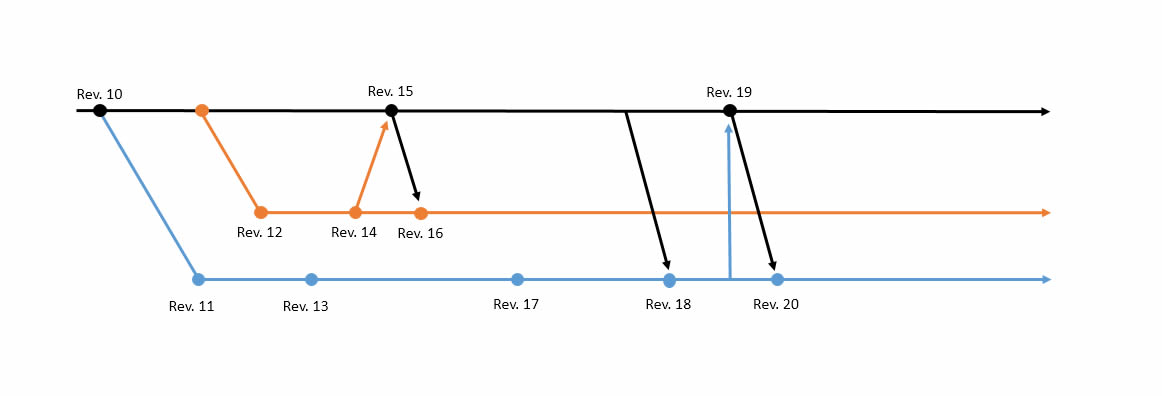SVN Developer Branch Flow
Ever wanted to use a branch workflow with SVN, but had trouble getting it to work or finding out information on how to manage branches? Yes I have, and I spent the best part of two days working it out only to realise it was not as bad as I thought. I was just about to ditch the idea when I finally worked it out by re-reading about SVN merging.
The Strategy
The idea is to have developer branches, so each developer can have their own working copy and manage it themselves. Once they have completed each ticket of work and are ready for go back onto the mainline (trunk), they merge the batch of revisions down to trunk ready for release.
The Issue
Note: I am not branching trunk as a whole, but branching a sub folder within trunk
All seemed to be going well-I was making changes to my branch and committing as and when I needed to. I then finished my first ticket and merged the code down to trunk. Another ticket was finished so I merged the code down to trunk. A couple of days later another developer had finished their work and merged to trunk. Now I need to pull their changes to my branch to keep my branch in sync, but this is where it all started to go wrong. Upon doing a sync merge to bring all changes on trunk, my branch did not know about the previous merges that I had made from my branch to trunk. It was trying to bring the merges I had made from my branch to trunk, and throwing errors about conflicts.
The error was “Reintegrate can only be used if revisions X through Z were previously merged from {repo} to reintegrate source, but this is not the case”
The strategy of developer branches seemed like a simple idea, but seemed to be causing many issues. My research lead me to find out in SVN 1.8 server, merge had been updated to be smarter about moving changes between trunk and branches. We got a 1.8 server running and copied over the repository to check if this was the case-still no difference. I eventually ran back into my issue above.
The Solution
As these branches are long running branches, and merges happen but then they are kept running, the branches are not being reintegrated back to trunk. So you need to keep them alive by keeping the branch in the loop of what has been merged to trunk. One might think if you merge from a branch to trunk, the branch will know what you merge to trunk. But that’s not the case with SVN. When you merge to trunk, you are only applying the changes from the merge to the local copy of trunk. These changes are not merged until you commit all these changes to trunk. By committing the merged changes to trunk you create a new revision number, and this new revision number is never passed back to the branch. In this instance you would normally be terminating the branch as your feature is complete, but as we want long running branches we have to keep the branch alive.
In order to do what we need and keep the branches alive, we need to follow the following flow (diagram to help follow along)
- Rev. 10 We create a branch of trunk (branch-a) , this creates revision 11
- Another branch is created from trunk (branch-b), this creates revision 12
- Marty is developing on branch-a and makes a change this makes revision 13
- Meanwhile Jen is developing on branch-b and has done a fix and commits making revision 14
- Jen is happy for revision 14 to pushed back to trunk, she merges here revision 14 to trunk, all goes OK, so she commits the merged changes creating revision 15 on trunk
- As the merge created revision 15, branch-b does not know this and in future sync merges on branch-b it will try to bring revision 15 back to the branch, and cause conflicts. So, Jen needs to merge revision 15 to branch-b, but not like a normal merge, she only needs to do a record only (–record-only) merge. This will tell branch-b not to try and merge revision 15 to the branch-b in the future
- Marty then makes a fix and creates revision 17
- Marty realises Jen made a fix he needs on his branch, so Marty does a sync merge onto branch-a and commits the merge code as normal
- Marty has fixed the issue he was working on in revision 13 & 17 and it’s time to merge into trunk, Marty merges his code to trunk, and merges the applied changes to trunk this creates revision 19
- Now Marty needs to merge revision 19 as a record only merge to branch-a to avoid SVN try to merge it in sync merges later on.
–record-only is the command line flag if you are using the command line to do your merges, if you are using a GUI there should be an option for it, in SmartSVN it’s in the advanced tab, see below:
Always remember to commit the folder when doing merge’s, this contains the merge info! Not doing so will cause issues in the future!

